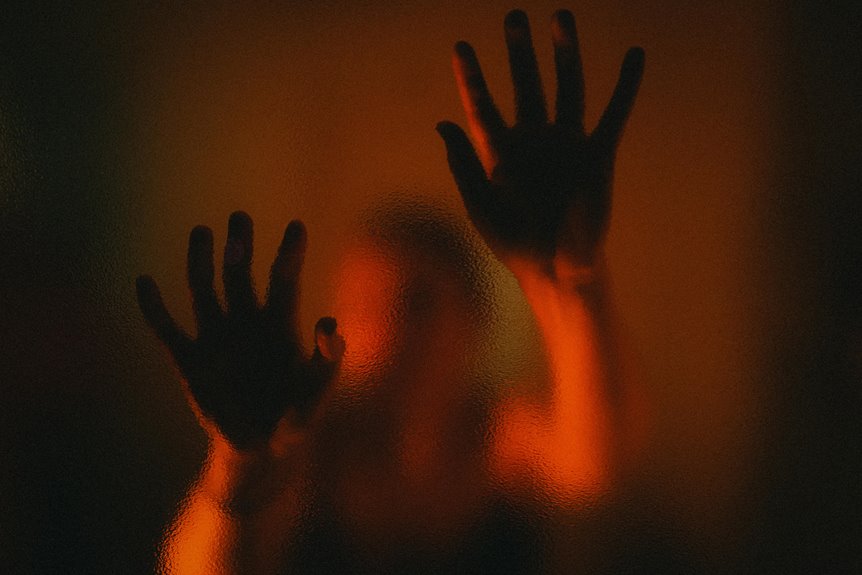To use a scrim for lighting diffusion, place the fabric between your light source and subject to soften harsh shadows and reduce glare. Make sure it’s stretched tightly on a frame and positioned perpendicular to the light. Adjust the distance to control softness—closer for broader diffusion, farther for more subtle effect. Avoid wrinkles or dirt on the scrim, and match its size to your light for even coverage. Keep experimenting, and you’ll discover ways to creatively enhance your lighting setups.
Table of Contents
Key Takeaways
- Position the scrim between the light source and subject to soften and evenly diffuse the light.
- Stretch the scrim fabric tightly on a frame to avoid wrinkles that affect light quality.
- Adjust the distance between scrim and light for desired softness; closer for broader diffusion.
- Keep the scrim perpendicular to the light path to ensure even light spread without harsh shadows.
- Experiment with scrim placement and angle to shape light and reduce glare effectively.
What Is a Scrim and Why Use It?
A scrim is a lightweight, translucent fabric that you place between your light source and the subject to soften harsh shadows and reduce glare.
When you use a scrim, it diffuses the light, making it more even and flattering. This helps prevent overly bright spots and sharp contrasts that can distract from your subject’s details.
You’ll find scrims especially useful in photography, videography, and theater lighting setups, where controlling light quality is essential.
By adjusting the distance between the scrim and the light or subject, you can fine-tune how soft or intense the light appears.
Using a scrim also reduces reflections and hotspots, giving your work a polished, professional look without needing expensive equipment or complicated setups.
Different Types of Scrims Explained
You’ll find scrims come in a few main types, like fabric scrims and metal frame scrims, each serving different purposes.
Some scrims diffuse light softly, while others reflect it to control brightness and shadows.
Understanding these differences helps you pick the right tool for your lighting needs.
Fabric Scrims Overview
Fabric scrims come in various types, each designed to control light in specific ways. When you use fabric scrims, you’ll find they soften harsh light, reduce intensity, and help create the perfect mood without altering color temperature.
Here are the common types you might encounter:
- Chiffon Scrims: Lightweight, sheer fabric for gentle diffusion.
- Silk Scrims: Provide soft, natural-looking light with minimal color shift.
- Grid Scrims: Feature a mesh pattern that cuts light directionally.
- Neutral Density (ND) Scrims: Reduce light intensity without changing color.
- Blackout Scrims: Block light entirely, useful for controlling spill.
Choosing the right fabric scrim depends on your lighting needs, so experiment to see which best suits your scene.
Metal Frame Scrims
Metal frame scrims offer versatile solutions for controlling light with sturdy structures that hold various diffusion materials.
When you use a metal frame scrim, you get a reliable, easy-to-handle option that keeps your diffusion fabric taut and wrinkle-free.
These scrims come in different sizes and shapes, often rectangular or circular, to fit your specific lighting setup.
The metal frame also allows quick attachment and removal of different diffusion gels or fabrics, so you can adjust your light softness on the fly.
Plus, they’re durable enough for outdoor shoots, resisting wind better than handheld fabric scrims.
When you want consistent, high-quality diffusion without hassle, metal frame scrims are a smart choice that streamlines your workflow and improves your lighting control.
Reflective vs. Diffusive
While metal frame scrims provide a sturdy base for diffusion materials, understanding the different types of scrims themselves can help you choose the right tool for your lighting needs.
Reflective scrims bounce light, giving you control over direction and intensity without harsh shadows. Diffusive scrims soften light by scattering it, creating a gentle, even glow that reduces contrast.
Here’s a quick breakdown:
- Reflective scrims: Use for directing light and adding highlights
- Diffusive scrims: Ideal for softening and spreading light evenly
- Material differences: Reflective often metallic or white; diffusive are translucent fabrics
- Portability: Diffusive scrims are usually lighter and easier to fold
- Application: Reflective scrims shape light; diffusive scrims reduce glare and shadows
Choosing the right scrim boosts your lighting quality considerably.
Choosing the Right Scrim Material for Your Shoot
Selecting the right scrim material plays an important role in shaping the quality of light for your shoot. You’ll want to take into account the level of diffusion each material offers—nylon mesh scrims provide gentle softening, while silks offer stronger diffusion to reduce harsh shadows.
Think about durability too; nylon scrims are lightweight and easy to handle, perfect for outdoor shoots, whereas silks are more delicate but create a beautifully soft look indoors.
Also, factor in the size of your setup; larger scrims need sturdier materials to avoid sagging.
Finally, check your lighting conditions—some scrims work better with natural light, others with artificial sources.
Choosing wisely guarantees your final footage or photos have that professional, flattering light you’re aiming for.
Setting Up Your Scrim: Step-by-Step Guide
Once you’ve chosen the right scrim material, it’s time to set it up for your shoot. Proper setup guarantees smooth diffusion and a professional look.
Start by assembling your support frame or stand, making sure it’s stable. Then, stretch the scrim fabric tightly across the frame to avoid wrinkles that can affect light quality. Secure the fabric at the corners using clamps or ties.
Double-check that the scrim is flat and evenly tensioned before moving to the lighting arrangement.
Here’s a quick checklist to guide you:
- Assemble and stabilize the frame or stand.
- Stretch the scrim fabric smoothly across the frame.
- Secure corners tightly with clamps or ties.
- Remove any wrinkles or folds.
- Confirm the scrim is evenly tensioned and flat.
Positioning the Scrim for Optimal Light Diffusion
Because the scrim’s position directly affects how light spreads and softens, you’ll want to place it thoughtfully.
Start by positioning the scrim between your light source and subject, adjusting the distance based on the softness you need. The closer the scrim is to the light, the broader and gentler the diffusion becomes. Moving it closer to your subject creates a more focused softening effect.
Also, keep the scrim perpendicular to the light path to guarantee even diffusion. Tilt or angle it slightly if you want to shape the light’s spread or reduce glare.
Experiment with height and side placement to avoid unwanted shadows. With careful positioning, your scrim will transform harsh light into a flattering, natural glow that enhances your scene beautifully.
Common Mistakes to Avoid When Using Scrims
Although scrims are simple tools, it’s easy to make mistakes that reduce their effectiveness. You want to make sure your lighting looks natural, so avoid these common pitfalls when using scrims.
- Don’t place the scrim too close to the light source; it can over-soften or unevenly diffuse light.
- Avoid using a dirty or wrinkled scrim, as imperfections show up in your lighting.
- Don’t ignore the angle of the scrim; improper angling can create unwanted shadows.
- Avoid using a scrim that’s too small for your light; it won’t diffuse evenly across your subject.
- Don’t rely solely on scrims without considering other lighting adjustments; scrims work best combined with good positioning.
Stay mindful of these, and your lighting will stay beautifully soft and balanced.
Creative Tips for Enhancing Your Lighting With Scrims
Mastering scrim placement and care sets the stage, but you can push your lighting further by experimenting with creative techniques. Try layering scrims to soften shadows progressively or angle them to shape light directionally. Use colored gels behind scrims for subtle tinting or combine scrims with reflectors to balance highlights and shadows. Don’t hesitate to adjust distance between scrim and light to control diffusion intensity.
| Technique | Effect |
|---|---|
| Layering scrims | Gradual softening of shadows |
| Angling scrims | Controlled light shaping |
| Colored gels + scrims | Gentle color tinting |
| Scrim + reflector | Balanced highlight and shadow |
Experiment often, and you’ll find unique lighting styles that elevate your visuals.
Frequently Asked Questions
How Do Scrims Compare to Softboxes in Lighting Quality?
You might expect scrims and softboxes to be the same, but they differ. Scrims offer flexible, natural diffusion, while softboxes provide consistent, controlled light. You’ll find each suits different moods and setups perfectly.
Can Scrims Be Used Outdoors in Windy Conditions?
You can use scrims outdoors in windy conditions, but you’ll need to secure them firmly with sandbags or clamps. Otherwise, they might flap or blow away, disrupting your lighting and causing safety hazards. Stay prepared!
What Maintenance Is Required for Scrims After Use?
After use, treat your scrim like a delicate flower—gently shake off dust, spot-clean stains, and air it out. Store it flat or rolled to avoid creases, ensuring it stays ready for your next light dance.
Are Scrims Compatible With All Types of Light Sources?
Scrims work with most light sources, but you’ll want to check compatibility, especially with high-heat or LED lights. Always use scrims designed for your specific light type to avoid damage and guarantee ideal diffusion.
Can Scrims Be Homemade With Common Household Materials?
Yes, you can make scrims at home using materials like white bedsheets, shower curtains, or parchment paper. Just stretch them over a frame to soften and diffuse light effectively without buying professional equipment.
- Why Open-Weave Scrim Is the Secret to Stunning Event and Canopy Designs - June 26, 2025
- Creating Large-Scale Art Installations With Scrim Fabric - June 26, 2025
- Scrim Fabric in Upholstery: Understanding Its Use as a Backing Material - June 26, 2025







